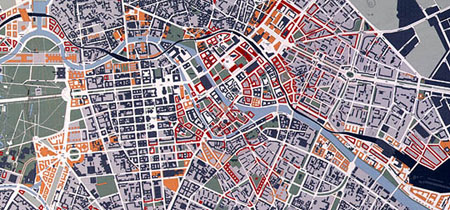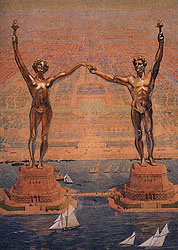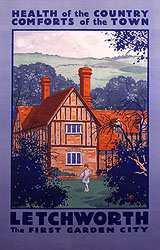
|
|
|
|
North-European cityplanning 1900-2000
 During the twentieth century, the space in which our life plays out has undergone radical changes. The exhibition 'Mastering the City' in the NAI presents a review of twenty-four city development schemes from the past hundred years - schemes we may regard as masterpieces of the planner's profession. The exhibition also traces the origins of general concepts for city design like the Garden City of Ebenezer Howard (1903), the Ville Radieuse of Le Corbusier and the Ville Spatiale of Yona Friedman (1958), and the concrete results that have emerged from these concepts. Of particular interest are the original drawings of these schemes which are on show. During the twentieth century, the space in which our life plays out has undergone radical changes. The exhibition 'Mastering the City' in the NAI presents a review of twenty-four city development schemes from the past hundred years - schemes we may regard as masterpieces of the planner's profession. The exhibition also traces the origins of general concepts for city design like the Garden City of Ebenezer Howard (1903), the Ville Radieuse of Le Corbusier and the Ville Spatiale of Yona Friedman (1958), and the concrete results that have emerged from these concepts. Of particular interest are the original drawings of these schemes which are on show.
 Another special feature is a group of urban schemes from Eastern Europe which have never been exhibited to the public before. These include the reconstruction scheme for Warsaw (1948) and a competition entry for a new government centre in Kiev (1935). The images from the past are very diverse, including Ebenezer Howard's idyllic Garden City, the monumental, totalitarian urban designs of Nazi Germany (Generalbebauungsplan Berlin 1938), the first official regional plan in Europe (the Ruhr 1920) and the plans for a new Dutch city (Almere 1977). Another special feature is a group of urban schemes from Eastern Europe which have never been exhibited to the public before. These include the reconstruction scheme for Warsaw (1948) and a competition entry for a new government centre in Kiev (1935). The images from the past are very diverse, including Ebenezer Howard's idyllic Garden City, the monumental, totalitarian urban designs of Nazi Germany (Generalbebauungsplan Berlin 1938), the first official regional plan in Europe (the Ruhr 1920) and the plans for a new Dutch city (Almere 1977).
Besides extending an opportunity to become acquainted with the history of urban planning, the exhibition deals with the future. It includes recent plans for two major cities, Berlin and Paris, and for two metropolitan regions, the Randstad and the Ruhr. Naturally, the scale of these planning issues is too immense for one exhibition. In the case of Paris, 'Mastering the City' presents the extension of the metropolis around Roissy-Charles de Gaulle Airport. Berlin is represented by the large-scale reconstruction of the city in the aftermath of the fall of the Wall. A scale model (8 x 8 m) shows how the separate main centres of the former East and West Berlin can be reunited. The crucial developments in the Ruhr concern the industrial and mining areas which have become redundant and are to be redeveloped, now mainly for housing and leisure. As in the Ruhr, the Randstad involves development in areas between the urban concentrations. The Randstad is different however in the tension that exists between open space and advancing urbanization.
|
 |
Mastering the City - North-European cityplanning 1900-2000
|
|


 During the twentieth century, the space in which our life plays out has undergone radical changes. The exhibition 'Mastering the City' in the NAI presents a review of twenty-four city development schemes from the past hundred years - schemes we may regard as masterpieces of the planner's profession. The exhibition also traces the origins of general concepts for city design like the Garden City of Ebenezer Howard (1903), the Ville Radieuse of Le Corbusier and the Ville Spatiale of Yona Friedman (1958), and the concrete results that have emerged from these concepts. Of particular interest are the original drawings of these schemes which are on show.
During the twentieth century, the space in which our life plays out has undergone radical changes. The exhibition 'Mastering the City' in the NAI presents a review of twenty-four city development schemes from the past hundred years - schemes we may regard as masterpieces of the planner's profession. The exhibition also traces the origins of general concepts for city design like the Garden City of Ebenezer Howard (1903), the Ville Radieuse of Le Corbusier and the Ville Spatiale of Yona Friedman (1958), and the concrete results that have emerged from these concepts. Of particular interest are the original drawings of these schemes which are on show. Another special feature is a group of urban schemes from Eastern Europe which have never been exhibited to the public before. These include the reconstruction scheme for Warsaw (1948) and a competition entry for a new government centre in Kiev (1935). The images from the past are very diverse, including Ebenezer Howard's idyllic Garden City, the monumental, totalitarian urban designs of Nazi Germany (Generalbebauungsplan Berlin 1938), the first official regional plan in Europe (the Ruhr 1920) and the plans for a new Dutch city (Almere 1977).
Another special feature is a group of urban schemes from Eastern Europe which have never been exhibited to the public before. These include the reconstruction scheme for Warsaw (1948) and a competition entry for a new government centre in Kiev (1935). The images from the past are very diverse, including Ebenezer Howard's idyllic Garden City, the monumental, totalitarian urban designs of Nazi Germany (Generalbebauungsplan Berlin 1938), the first official regional plan in Europe (the Ruhr 1920) and the plans for a new Dutch city (Almere 1977).